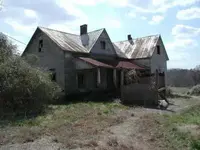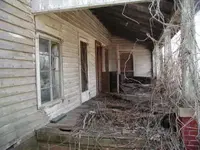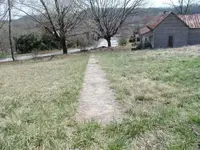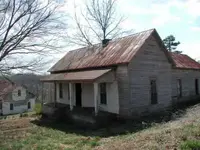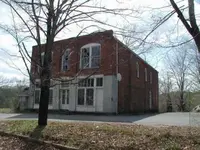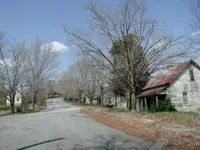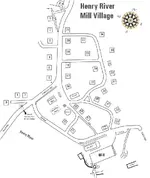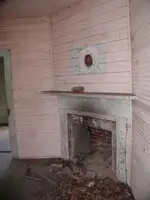Gypsy Heart
Gold Member
- #1
Thread Owner
Huddled in the hills of North Carolina -- not too far outside of Hildebran but clear on the other side of the county from Broughton, the state's largest mental hospital -- there lies a ghost town named Henry River. The abandoned homes and company store are always eerie, but there is something in the light of dusk that makes them even more so: gap-toothed windows sprout trees; slack doors open to nothing. Built in the early 1900's around a textile mill, the town peaked fast but fell soon. In fact, it hardly made it past sixty -- an age most of us would deem too young to die. In its time, however, Henry River was remarkable: it generated its own electricity and operated under its own currency; it ran its own school and its own church; swam in its own swimming hole and churned its own moonshine, but the community that once thrived now sits as empty as an unpaired shoe.
From the Past:
Henry River Mill Village
by Mickie Vacca, Executive Director, Historic Burke Foundation
"Voice of the Foothills" Newspaper, February 2003
Sitting on the eastern edge of Burke County is a preserverationist's dream, a diamond in the rough, the Henry River mill village. Built as a planned community, the Henry River mill village was a self-contained complex with its own mill, dam, water and fire-protection systems, and company store. In later years the Henry River village gained amenities such as walkways, terraced green spaces, and fieldstone retaining walls. Today most of the village's original buildings remain sited along a small gorge of the Henry River, west of the Catawba County line, the most intact and unaltered example of an early industrial environment in Burke County.
In 1904 Michael Erastus Rudisill laid out the mill and village on a 1500-acre tract, chosen for its hydropower potential. Rudisill, along with his brother Albert Pinkney Rudisill, built the village and engineered the dam and mill building along with David William Aderholdt, Miles R. Rudisill, and Marcus Lafayette Aderholdt. The mill was incorporated as the Henry River Manufacturing Company. The company manufactured fine cotton yarns. Beginning in 1905, a 30-foot reinforced concrete dam was constructed with a three-story brick mill building. The mill building burned in 1977.
The residential area of the village consisted of approximately 35 small worker's cottages. Twenty-one are standing today. These 1-1/2 story duplex houses were laid out along the steep contours of the river's northern bank. The workers lived in boarding houses or workers' cottages built by the company, which were leased at nominal fees.
Around 1907 the four mill owners, the Rudisills and the Aderholdts, built new homes for themselves just outside the village. Although one burned in 1935, three of the four houses are still standing today.
Since the loss of the main mill building, the centerpiece of the village today is the two-story brick company store building. This building served as a mill office with the upper floor used as a school room and for church services from 1907-1917. In 1912 a steel truss bridge engineered by the Rudisills was built across the Henry River. When built, it was reputed to be the highest bridge in the state. During the 1916 flood, this bridge was one of the few not destroyed. In 1960 a new concrete bridge replaced the steel truss bridge.
The Henry River Mill originally ran on waterpower. In 1914 a steam plant was installed then in 1926, the mill was converted to electric power. The mill was closed for several years and was purchased by Wade K. Shepherd in 1976. Equipment and materials were stored in the mill building when it burned in 1977.
The mill and village are designated to the North Carolina Study List of the National Register of Historic Places. Late in 2002 through the Burke County Partners in Economic Development's Heritage Preservation Committee began efforts to explore development of the historic site for the benefit of all Burke County citizens. Early in 2003 the formation of a Henry River Mill Village Committee has begun looking into working with the property owner to devise ways of preserving the mill village intact.
North Carolina has an established record of preserving important industrial sites. Some other mill villages that have been developed very successfully in North Carolina are Glencoe mill village in Alamance County, the Eden Mill complex in Chowan County, and the cultural arts center being developed near Hendersonvill at the Grey Mill Complex. Suggested uses for the Henry River mill village have been as a residential community, as a resotred historic mill site, or as a cultural heritage center showcasing artisans of North Carolina and their crafts.
The presence of the site on the North Carolina Register Study List puts it one step closer to eligibility for North Carolina dn Federal tax credit programs. The property can be developed for commercial or private uses. Using preservation covenants and following the Secretary of Interiors standards for restoration, buyers can take advantage of either 40% commercial tax credits or 30% private tax credits. The PEG's Heritage Preservation Committee is actively working to encourage interest in this important remnant of the change in American lifestyle from an agrarian to an industrial society. Today the remaining buildings of the Henry River mill village speak eloquently of the industrial heritage of Burke County.
From the Past:
Henry River Mill Village
by Mickie Vacca, Executive Director, Historic Burke Foundation
"Voice of the Foothills" Newspaper, February 2003
Sitting on the eastern edge of Burke County is a preserverationist's dream, a diamond in the rough, the Henry River mill village. Built as a planned community, the Henry River mill village was a self-contained complex with its own mill, dam, water and fire-protection systems, and company store. In later years the Henry River village gained amenities such as walkways, terraced green spaces, and fieldstone retaining walls. Today most of the village's original buildings remain sited along a small gorge of the Henry River, west of the Catawba County line, the most intact and unaltered example of an early industrial environment in Burke County.
In 1904 Michael Erastus Rudisill laid out the mill and village on a 1500-acre tract, chosen for its hydropower potential. Rudisill, along with his brother Albert Pinkney Rudisill, built the village and engineered the dam and mill building along with David William Aderholdt, Miles R. Rudisill, and Marcus Lafayette Aderholdt. The mill was incorporated as the Henry River Manufacturing Company. The company manufactured fine cotton yarns. Beginning in 1905, a 30-foot reinforced concrete dam was constructed with a three-story brick mill building. The mill building burned in 1977.
The residential area of the village consisted of approximately 35 small worker's cottages. Twenty-one are standing today. These 1-1/2 story duplex houses were laid out along the steep contours of the river's northern bank. The workers lived in boarding houses or workers' cottages built by the company, which were leased at nominal fees.
Around 1907 the four mill owners, the Rudisills and the Aderholdts, built new homes for themselves just outside the village. Although one burned in 1935, three of the four houses are still standing today.
Since the loss of the main mill building, the centerpiece of the village today is the two-story brick company store building. This building served as a mill office with the upper floor used as a school room and for church services from 1907-1917. In 1912 a steel truss bridge engineered by the Rudisills was built across the Henry River. When built, it was reputed to be the highest bridge in the state. During the 1916 flood, this bridge was one of the few not destroyed. In 1960 a new concrete bridge replaced the steel truss bridge.
The Henry River Mill originally ran on waterpower. In 1914 a steam plant was installed then in 1926, the mill was converted to electric power. The mill was closed for several years and was purchased by Wade K. Shepherd in 1976. Equipment and materials were stored in the mill building when it burned in 1977.
The mill and village are designated to the North Carolina Study List of the National Register of Historic Places. Late in 2002 through the Burke County Partners in Economic Development's Heritage Preservation Committee began efforts to explore development of the historic site for the benefit of all Burke County citizens. Early in 2003 the formation of a Henry River Mill Village Committee has begun looking into working with the property owner to devise ways of preserving the mill village intact.
North Carolina has an established record of preserving important industrial sites. Some other mill villages that have been developed very successfully in North Carolina are Glencoe mill village in Alamance County, the Eden Mill complex in Chowan County, and the cultural arts center being developed near Hendersonvill at the Grey Mill Complex. Suggested uses for the Henry River mill village have been as a residential community, as a resotred historic mill site, or as a cultural heritage center showcasing artisans of North Carolina and their crafts.
The presence of the site on the North Carolina Register Study List puts it one step closer to eligibility for North Carolina dn Federal tax credit programs. The property can be developed for commercial or private uses. Using preservation covenants and following the Secretary of Interiors standards for restoration, buyers can take advantage of either 40% commercial tax credits or 30% private tax credits. The PEG's Heritage Preservation Committee is actively working to encourage interest in this important remnant of the change in American lifestyle from an agrarian to an industrial society. Today the remaining buildings of the Henry River mill village speak eloquently of the industrial heritage of Burke County.



